|

 Up
Up 
 1906 Aero Club
1906 Aero Club
Exhibition

(You are here.)
 Down
Down




  Need
to Need
to
find your
bearings?
Try
these
navigation aids:
If
this is your first
visit, please stop by:
Something
to share?
Please:



|
|
Available in Française, Español, Português, Deutsch, Россию,
中文,
日本, and others.
[Ed. – In late 1905, several members of America's technological
elite organized the Aero Club of America. It had already been
operating informally for over a decade, but in November 1905 they
adopted a charter patterned after the
Aéro Club de France. One of the purposes
of the formalized ACA was to share and disseminate information about the emerging
field of aviation and aeronautics. It's very first undertaking was
to stage a trade show at the 69th Regiment Armory in New York City,
bringing together flight-minded folks from all over America and
Europe. From January 13 through January 20, the Aero Club of
America Exhibition of Aeronautical Apparatus showed the state of the
flying art in 1906.
It was a turning point in aviation and no one felt its effects
more than the Wright brothers – even though they just barely
participated. At the invitation of
Dr. Albert Zahm of Catholic University, they paid the $20
membership fee to join the club. (Zahm was an acquaintance of theirs
with whom the brothers had corresponded about their wind tunnel work
and powered flights.) They then sent the
crankshaft and the flywheel from their damaged 1903 Wright Flyer
engine, along with a few photographs – but they did not go
themselves. The same week that the exhibition opened, Scientific
American magazine published a snarky editorial entitled "The
Wright Airplane and its Fabled Performance" intimating that the
Wrights had grossly exaggerated their success in a report they had
sent to
Ferdinand Ferber, a member of the
Aéro Club de France. This was in contrast to
the photos the Wrights had sent to the exhibit, which showed their
success was real.
It also contrasted with letters that Zahm had exchanged with the
Wrights and a report that
Charles Manly had given to the Aero Club of New York on 14
November 1905, describing the test flights of the Wright brothers in
1904 and 1905. (Manly may have surreptitiously witnessed some of
those flights.) Manly, Zahm, and other Aero Club members in the know
apparently talked to aeronautical
enthusiast William J. Hammer. Hammer was an accomplished scientist
who had helped Edison develop the electric light and first proposed
radium as a treatment for cancer. He was also a founding member of
the Aero Club of America and had an extensive photo collection of
aeronautical experiments which he displayed at the exhibition.
The conflict between the
Scientific American article and other reports that he was hearing
peaked Hammer's curiosity.
After the show, Hammer traveled to Dayton, Ohio and talked to the
brothers. He came away certain that Orville and Wilbur had not
exaggerated their accomplishments. He went back to New York City and
convinced other members of the club to endorse the Wrights.
Dr. Alfred Zahm, because he was already their acquaintance, was
asked to contact them. In a letter to the
Wrights, Zahm suggested they prepare a statement describing their
experiments and that the Aero Club would adopt it as a resolution.
"This would be the first formal identification that your countrymen
appreciate your work and are proud of it. It may also prove of
historical value in showing that the specialists of your day regard
you as the inventors of the first successful flying machine."
The Wrights were agreeable; the Scientific American
article had stung. Another in a German magazine had plainly called
them "bluffers." They had been secretive while developing their
airplane, staying out of the news until their patent was secure. But
now it was time to be more forthcoming. They didn't yet have their
patent – it would not be granted until May 22 of that year – but no
doubt their lawyer had told them their application had passed the
Patent Office's litmus test. So they wrote
a straightforward account
of their flights at Huffman Prairie which the Aero Club adopted and
published along with its own resolution in March. Within a few
weeks, Scientific American conducted their own investigation.
On April 7, the magazine told its readers that "There is no doubt
whatever that these able experimenters deserve the highest credit
for having perfected the first flying machine of the
heavier-than-air type which has ever flown successfully and at the
same time carried a man."
The following is Scientific American's description of the
Aero Club of America Exhibition of Aviation Apparatus. It's a
snapshot of American aeronautics just as the Wright brothers began to
have an effect.]



From Scientific American,
Volume XCIV, No. 4, January 27, 1906, pps. 93-94
A most interesting exhibit, in connection with
the Sixth Annual Automobile Show held recently in the 69th Regiment
Armory, was that made by the newly-formed Aero Club of America. This
exhibit was the most complete of its kind ever held in any part of
the world, for all types of flying machines, balloons, and airships
were represented. In the same room with Santos-Dumont's No. 9
airship was to be seen one of the original gliding machines of Herr
Otto Lilienthal, as well as the gasoline and steam-propelled
aerodromes of Prof. Langley and the motor-driven aeroplane models of
Herring and Hargrave. Other apparatus shown consisted of Prof.
Bell's tetrahedral kite, Ludlow's combined box kite and aeroplane,
Myer's electrical torpedo, and Kimball's heliocoptere. The original
Hargrave box kite was also shown, as well as numerous models
designed by Herring and Chanute. Besides these very complete
exhibits of apparatus, the walls of the room were covered with a
large collection of photographs showing the machines of other
inventors, such as Whitehead, Berliner, and Santos-Dumont; and other
photographs showing airships and balloons in flight, together with
bird's-eye views taken from the same. In another room cinematograph
exhibitions were given twice every day. The views shown consisted of
motion pictures of the Vanderbilt automobile race, the Mount
Washington hill climb, balloon ascensions, and experiments in
raising aeroplanes when towing them by means of a motor boat. In
showcases placed in the exhibition hall were seen primitive models
of flying machines from the Patent Office at Washington, light
motors and other appliances for aeronautical work, together with a
collection of books bearing on the subject. Among the exhibits of
apparatus of historic interest were the large wood propellers which
Mr. Herring used on the first motor-driven, man-carrying aeroplane
to make a flight from the ground. This machine, according to Mr.
Herring, was propelled by a small compressed-air motor. On October
22, 1898, he informs us that it flew with its operator a distance of
72 feet in S seconds against a 25-mile-an-hour wind. Another exhibit
of great interest at the present time, in view of the claims of
remarkable flights made by the Wright brothers last summer, was the
four-throw crankshaft and flywheel of the motor said to have been
used on their machine when, on December 17, 1903, they made their
first flight with a motor-driven aeroplane at Kitty Hawk, N. C.
These experimenters claim to be using the same cylinders with their
latest machine, the motor of which they have fitted with a lighter
crankshaft. The crankshaft shown weighed in the neighborhood of 30
pounds.
Among the model self-propelled aeroplanes
shown, those of Prof. Langley should undoubtedly have first mention.
The steam-driven machine flew about half a mile over the Potomac
River at Quantico, Va., a little less than ten years ago, or on May
6, 1896. This was the first flight of a motor-driven aeroplane. The
gasoline-propelled model (which has a five-cylinder air-cooled
motor, the cylinders being arranged in a circle) made numerous
shorter flights in August, 1903. Prof. Langley's models are
constructed on the following plane principle. The original inventor
of this device, which was first brought out about 1878, was Mr.
Brown, and samples of Brown's "bi-planes," as they are termed, are
shown on page 93. A lift of only about 20 pounds to the horse-power
is possible with this system, as against a lift of from 100 to 150
pounds per horsepower with the superposed plane type. In actual
practice Langley obtained about 18 pounds lift. Langley's complete
steam machine weighed 30 pounds, while the motive plant developed
11.4 BHP. The gasoline model was one-quarter the size and
one-sixteenth the weight of Langley's man-carrying machine. It
weighed 58 pounds, of which 10 pounds was in the 10 horsepower
engine. As to the actual flights of these machines, there can be no
question, for the one on the date mentioned was witnessed by Prof.
Bell, and photographs were taken of the machine in flight.
Another interesting model is that exhibited by
Mr. Herring, and which he claims has made numerous successful
flights. When tethered to a high pole with a long cord, this machine
is said to have flown 15 miles in a circle in December, 1902, and to
have stopped only when the gasoline supply gave out. A
single-cylinder, air-cooled gasoline motor having
mechanically-operated inlet and exhaust valves and a make-and-break
igniter, all worked from a single cam, and carrying a small
propeller on its crankshaft, was shown on this machine. The weight
of the motor was said to be only 2 pounds, and its maximum
horse-power 0.51 at 3,400 RPM. In flight, however, the engine only
made about 850 RPM. and developed but 0.07 horsepower. The aeroplanes of this model (which is shown in the lower left-hand
picture on the preceding page) were 5-1/4 feet long by 14 inches
wide, and the 19-inch propeller which was fitted drew them through
the air at a speed of about 30 miles an hour. This machine is of the
usual rectangular, curved, superposed plane type invented by Chanute
and Herring about the year 1896. Its successful operation is said to
be due to an equilibrium-maintaining device which its inventor
prefers to keep secret. No photographs of this or of larger
man-carrying machines in flight were shown, nor has any trustworthy
account of their reported achievements ever been published. A single
blurred photograph of a large birdlike machine propelled by
compressed air, and which was constructed by Whitehead in 1901, was
the only other photograph besides that of Langley's machines of a
motor-driven aeroplane in successful flight. In order at least
partially to substantiate their claims, it would seem as if
aeroplane inventors would show photographs of their machines in
flight. This has been done by Mr. Maxim and Prof. Langley; and on
account of his desire to secure photographs of his tetrahedral kites
in mid-air. Prof. Bell uses red silk in their construction instead
of nainsook, which he prefers, but which, owing to its light color,
is difficult to photograph.
In contrast to the great secrecy of the later
aeroplane experimenters, should be noted the free manner in which
that first great experimenter in gliding flight, Otto Lillenthal,
gave the results of his experiments to the world. One of the early
gliding machines used by him in 1893 was exhibited, and a photograph
of this machine is to be seen on page 93. Had it not been for his
untimely death in 1896, from the breakage of his machine while in
flight, there is scarcely any doubt that he would have solved the
problem of the motor-driven aeroplane some years ago; for he was not
only a thorough mathematician and physicist, a clever constructor
and mechanical engineer, but he was also possessed of that daring
and physical dexterity which is a valuable aid to one attempting to
solve such a problem.
One of the most interesting exhibits was Prof.
Bell's tetrahedral kite shown on the preceding page, and a 408-cell
model of the huge 1,300-cell man-carrying kite "Frost King," which
was fully described in Supplement No. 1432, and which carried over
280 pounds. Despite the apparent frail structure of these
tetrahedral cells, their great strength when assembled was
demonstrated by the placing of a 190-pound man upon a mass of 100 or
more without damage. The kite we illustrate, by means of its tipping
tail worked by a pendulum in the bow, will descend in long graceful
curves when released in mid-air, and several times it has described
complete circles before alighting, in much the same manner as does a
soaring bird.
Among other interesting exhibits were examples
of balloon wicker baskets equipped with appliances for sketching and
photographing the country, and for making weather observations. The
frames of two dirigible balloons, the "Santos-Dumont No. 9" and "The
California Arrow," were exhibited. Both were equipped with
air-cooled gasoline motors of the lightest construction.
A complete set of apparatus used by the weather
bureau formed still another extremely interesting exhibit.
The greatest credit should be given to the
Committee of the Aero Club, and especially to its able secretary,
Mr. Augustus Post, for the exhibit made at the Armory. Not only will
this exhibit tend to stimulate interest in the art of flying, but,
followed by the active interest of the Club in matters pertaining to
the art, it should greatly promote the development and perfection of
the practical flying machine.
In Their Own Words
- Pulling Back the Curtain
– At the request of the Aero Club of America, the Wrights publish the
results of their 1904 and 1905 experiments at Huffman Prairie for the
first time.
|
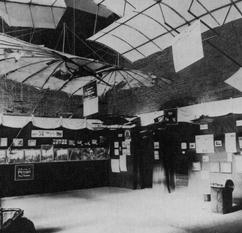
One room of the 1906 Aero Club Exhibition in the 69th Regiment
Armory in New York City. An original Lilienthal glider and
Chanute-Herring glider are suspended overhead. William J. Hammer's
photo collection is displayed on the wall to the left. The
crankshaft and flywheel from the 1903 Wright Flyer engine is on a
display table at the right. Interesting note: These engine parts
were never returned to the Wright brothers. The engine on the original Flyer in the Smithsonian
Air & Space Museum was
built in 1916, pieced together from the remaining original parts and
many new ones -- including a new crankshaft and flywheel.
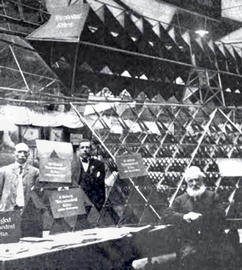
Alexander Graham Bell (lower center) displayed his tetrahedral kites
in an adjacent room in the Armory. (Bell would eventually see his
associate John McCurdy fly a tetrahedral wing aircraft is 1912.)
Overhead is the gondola and engine from Alberto Santos-Dumont's
Airship No. 9.
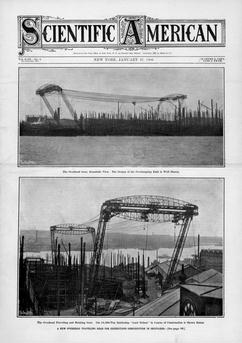
The cover of the January 27, 1906 edition of Scientific American
showed a huge crane designed to construct a warship.
Side and End Views of Prof. Bell's Tetrahedral Kite, Which, When
It is Released in Mid-Air, Descends in a Series of Curves, and
Sometimes Describes a Complete Circle Like a Soaring Bird.

This photograph shows the rear of the kite, which is made up of
tetrahedral cell constructed of spruce sticks 4mm (0.157 inch) and
25 cm (9.843 inches) long, bound together with fine twine and
covered with red silk. The weight of a single cell is 9-1.2 grams or
1/3 of an ounce.
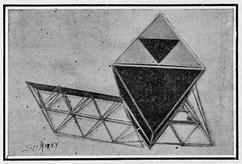
This view shows the tail tipped upward, which is accomplished
automatically by a pendulum in the bow when the kite makes a dive.
Langley's Steam Aerodrome -- the First Power Driven Airplane to
Fly
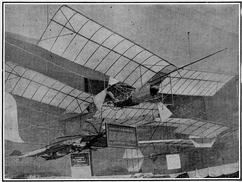
The first successful flight of this machine was at Quantico,
Virginia on May 6, 1896. The rudder at the left of this picture
forms part of Lilienthal's gliding machine. In the right-hand corner
of the room is seen the Herring-Arnot two-surface aeroplane which
has been used successfully by Mr. Herring and the Wright brothers.
Herring Dome Kite of 1898
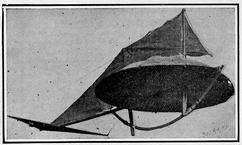
With this kite the center of pressure is almost constant with widely
varying angles of inclination. It's lifting power is also high.
Samples of Brown's Bi-Planes
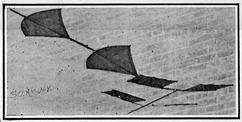
This type of aeroplane consisting of two following surfaces was
invented about 1878. Langely's aerodrome was built on this plan. But
20 pounds per horsepower can be lifted with this type of machine,
where from 100 to 150 pounds per horsepower can be lifted with the
superposed plane type.
The Motor and Basket of Santos Dumon't's No. 9 Airship.
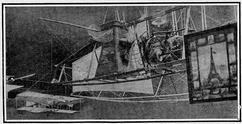
A blower is arranged to blow on the motor cylinders to cool them
properly. A large bicycle wheel acts as a flywheel and the shaft
carrying the propeller runs forward to the front of the framework.
The model two-surface aeroplane in the left-hand corner is a
motor-driven model which is said to have made numerous successful
flights.
One of the Original Lilienthal Gliding Machines with Which He
Made Hundreds of Successful Flights
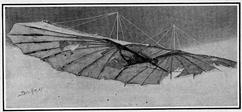
This machine has a rudder which is shown in the view of Langley's
aerodrome. Lilienthal succeeded in steering in a sharp curve to
right or left with this machine.
|